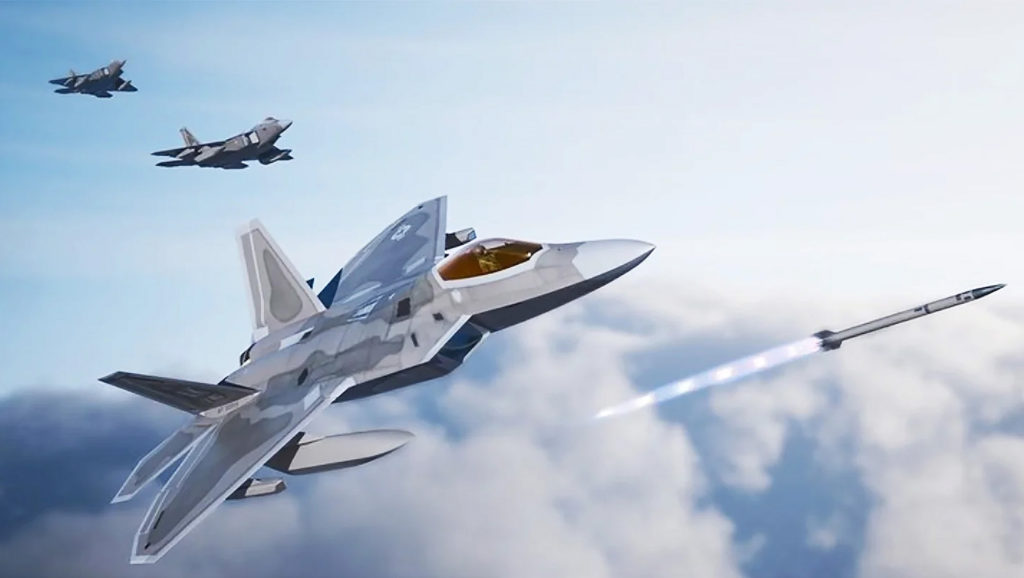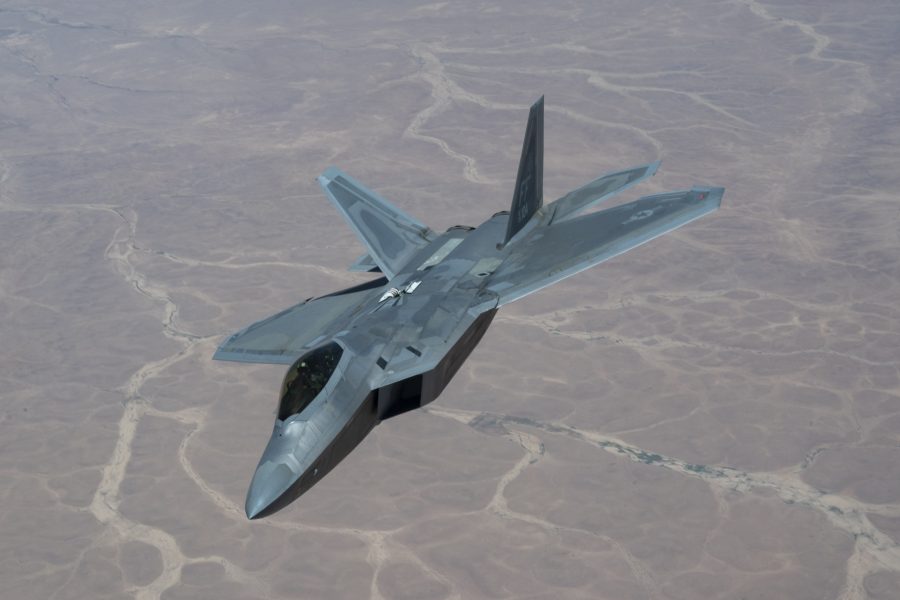The Air Force seems to be rethinking its plan to start retiring the F-22 around 2030, as its spending plans for the air dominance fighter go well beyond that date, according to the service’s fiscal 2025 budget request.
The Air Force’s planned F-22 budget through fiscal year 2029 includes $4.7 billion for procurement and $3.1 for research, development, test, and evaluation, for a total of $7.8 billion. While the RDT&E line closes out in FY29, procurement beyond that date—labeled “to completion” in budget documents—comes to $1.2 billion.
Senior Air Force leaders have described the F-22 program now through 2030 as a “bridge” to the Next-Generation Air Dominance Fighter and its family of systems, and several have said that the technologies being developed for the F-22 in its waning service years will be directly applicable to NGAD.
The budget assumes the F-22 fleet will be reduced by 32 aircraft, to about 153 airplanes, but the documents say only 142 will receive the full lineup of improvements.
The 32 jets the Air Force wants to divest are of the Block 20 configuration, and Air Force Secretary Frank Kendall has said it would cost upwards of $50 million each to bring them up to Block 30, the most up-to-date standard. The Air Force prefers to spend that money making the younger models more capable against the anticipated threat; mainly the air-to-air challenge posed by China’s fifth-generation fighters and advanced air-to-air missiles.
The Air Force has also said that a congressional mandate to upgrade the older F-22s—which have been used only as training jets—couldn’t be accomplished until it was almost time to retire them. They would also need all the new capabilities the F-22 is receiving, to preserve fleet standardization, at even greater cost.
Pentagon officials agreed that, despite the urgency of the threat, it would be foolish to upgrade the F-22s at such expense and retire them a few months later. One said that the timing of the F-22’s retirement “hasn’t been decided … and it depends on progress with NGAD” and other factors.
Budget justification documents for the F-22 say that the procurement activities over the next five years will upgrade “the air vehicle, engine, Operational Flight Program (OFP), and training systems to improve F-22 weapons, communications, navigation, pilot-vehicle interface, and electronic warfare suite.”
Updates called out in the documents show the Air Force is giving the F-22 stealthy, range-extending drop tanks, infrared sensors, identification, friend-or-foe improvements, better Link 16 connectivity, software upgrades, and electronic warfare and navigation enhancements, as well as new weapons and hardware changes to make it more reliable and available.
The long-range tanks and infrared systems were revealed in artwork released by Air Combat Command in mid-2022, without explanation at the time. Test aircraft sporting the new underwing tanks and IR sensors have since been photographed near western test ranges, but the Air Force has declined to discuss them.

The budget documents say the critical design review for the stealthy tanks took place in early 2023 and that technology demonstrations have been underway since. “Required Assets Available” with the tanks, which usually translates to initial operational capability, is set for the second quarter of fiscal 2026.
The infrared detection system (IRDS), which is likely to be the two slender, chiseled pods on the outer wing of the F-22 in the artwork, will enter full-up flight test in the first quarter of fiscal 2026. Production is to begin in early 2028, with deliveries the following year.
A sensor enhancement package for the F-22 includes IRST and possibly radar and other detection systems. Together, they will “improve the F-22’s sensing and tracking and ensures Air Superiority by preserving the first-look, first-shot and first-kill capabilities of the 142 Block 30/35 F-22 aircraft,” according to the justifications.
“The first 71 Sensor Enhancements Group A kits were purchased under F-22’s Rapid Fielding Middle Tier Acquisition (MTA) program authority,” the Air Force said. The new sensors are slated for flight demonstration in FY24. A follow-on production decision is scheduled to follow closely. Developmental Test and Evaluation is scheduled for the third quarter of FY25, and in the last quarter of FY26, Operational Test and Evaluation will begin.
The low-drag tank and pylons “are advanced technological designs” which will “minimally increase drag” while permitting longer range, even at supersonic speed, for the F-22.
“The pylons are equipped with smart rack pneumatic technology to accurately control ejection performance and maintain minimum drag without stores,” the documents said.
The program calls for 286 each of the tanks and pylons—enough to fully equip 143 jets, at two for each jet. They have to work at a speed of at least Mach 1.2. Wind tunnel and ground tests were completed in fiscal 2023, and flight testing is targeted to begin in the second quarter of fiscal 2024, shortly after which a critical design review is scheduled. The initial lots will be bought later in FY24. Developmental and operational testing is set to conclude in mid-fiscal 2026, with required assets available soon after.
The F-22 will also get a new Controlled Reception Pattern Antenna to help it navigate in a “GPS-degraded environment,” and achieve resilient position, navigation and timing. Retrofits will be made on 142 F-22s, of which 27 will be operated by the Air National Guard. There will be a production readiness review in June of this year, and flight testing starts in early 2025.
A series of reliability, availability, and maintainability program (RAMP) initiatives meant to make the F-22 more ready when needed are also in the funding plan. Candidates were selected for their ability to rapidly reduce maintenance workload or increased durability of the F-22’s stealth features. There is “high variability in the number of projects and kit quantities,” the Air Force said in its budget justification books.
“The RAMP program includes funding for retrofit installation labor and modifications which address corrosion, reduce maintenance hours, increase safety and provide urgent response requirements identified by the user to the F-22 fleet,” the Air Force said. These projects are also addressing safety-of-flight issues and to ease “technology insertion.” One such program replaces old fiber-optic cabling; another for a “Low Observable Mighty Tough Boot … leads to an estimated three percent increase in aircraft reliability.”
What was originally an ad-hoc Link 16 connectivity program now gives the F-22 a transmit/receive capability with Link 16 rehosted to a system that also plugs it into the Multi-functional Information Distribution Service/Joint Tactical Radio System (MIDS/JTRS), with an open architecture to speed insertion of new capabilities.
Much of the F-22 RDT&E request is for software to integrate and exploit all the new sensors and equipment the fleet will receive. The Air Force is attempting to “leverage commercially-based agile software and hardware best practices and tools” to speed the introduction of new capabilities. It’s also funding Software Integration Labs for most of the specific systems.
Other RDT&E efforts include cryptographic upgrades, technology demonstrations, “threat modeling support,” engine enhancements cybersecurity and open mission system (OMS) integration. Software is to be delivered “using a scheduled cadence for capabilities as they mature.”
The RDT&E program also includes “Project Geyser,” described as an “advanced capability” that will be assessed for “fielding configuration options.” No details were given about this project, but there will be “continued flight demonstrations and … test fleet modification into planned production configuration” in fiscal 2025.
